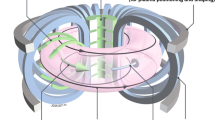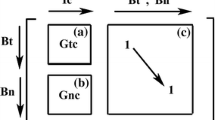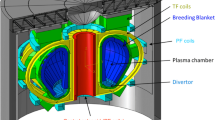Abstract
In tokamaks non-axisymmetric magnetic field perturbations (error fields) can induce in plasma locked modes and cause disruption. In ITER the main contributor to error fields is assembly and manufacturing errors of the magnet system of the machine. To suppress intrinsic error fields and guarantee the expected plasma performance ITER is provided with the proper correction coils (CC). The paper is related to optimization of CC currents. The optimization takes into account as constraints both CC current capacities and an allowable level of error fields.
Similar content being viewed by others
References
R. J. La Haye, R. Fitzpatrick, T. C. Hender, A. W. Morris, J. T. Scoville, and T. N. Todd, “Critical error fields for locked mode instability in Tokamaks,” Phys. Fluids 4, 2098–2103 (1992).
G. M. Fishpool, D. J. Campbell, R. Fitzpatrick, and P. S. Haynes, “A locked mode associated with low density in JET,” in Proceedings of IAEA Meeting on Avoidance and Control of Tokamak Disruption (1991), p. 84.
R. Fitzpatrick and T. C. Hender, “The interaction of resonant magnetic perturbations with rotating plasmas,” Phys. Fluids 3, 644 (1991).
R. J. la Haye, “Physics of locked mode in ITER: error field limits, rotation for obviation, and measurement of error fields,” US Home Team Physics Contribution: General Atomics report GA-A22468 (1997).
T. C. Hender et al., “MHD stability, operational limits and disruptions,” in Progress in ITER Physics Basis, Nucl. Fusion 47, 512–515 (2007).
A. Foussat, P. Libeyre, N. Mitchell, et al., IEEE Trans. Appl. Supercond. 20, 402–406 (2010).
N. Mitchell and J. Knaster, “Contributions to plasma error fields from the CS, PF and TF coils,” ITER report ITER-D-23DVQU (2006).
J. Knaster,“Updated data. Magnets manufacturing and positioning tolerances,” ITER report ITER-D-6YBRVW (2011).
V. Amoskov, A. Belov, V. Belyakov, et al., “Fourier analysis of 3D error fields in Tokamaks,” Plasma Dev. Operation 12, 285–297 (2004).
J.-K. Park, A. H. Boozer, J. E. Menard, and M. J. Schaffer, “Error field correction in ITER,” Nucl. Fusion 48, 45 (2008).
A. Tikhonov and V. Arsenin, Methods of Solving Incorrect Problems (Nauka, Moscow, 1979) [in Russian].
V. Amoskov, A. Belov, V. Belyakov, et al., “Statistical analysis of expected error fields in Tokamaks and their correction,” Plasma Dev. Operat. 13, 87–103 (2005).
J. Knaster, V. Amoskov, A. Formizano, et al., “ITER non-axisymmetric error fields induced by its magnet system,” Fusion Eng. Des. 86, 1053–1056 (2011).
V. Amoskov, A. Belov, Y. Gribov, et al., “Error fields produced by TF, CS and PF coils and their correction (3-mode criterion),” ITER report ITER-D-3UYV33 (2010).
Author information
Authors and Affiliations
Corresponding author
Additional information
The article is published in the original.
Rights and permissions
About this article
Cite this article
Amoskov, V.M., Belyakov, V.A., Gribov, Y.A. et al. Optimization of currents in ITER correction coils. Phys. Part. Nuclei Lett. 12, 375–379 (2015). https://doi.org/10.1134/S1547477115030048
Published:
Issue Date:
DOI: https://doi.org/10.1134/S1547477115030048




